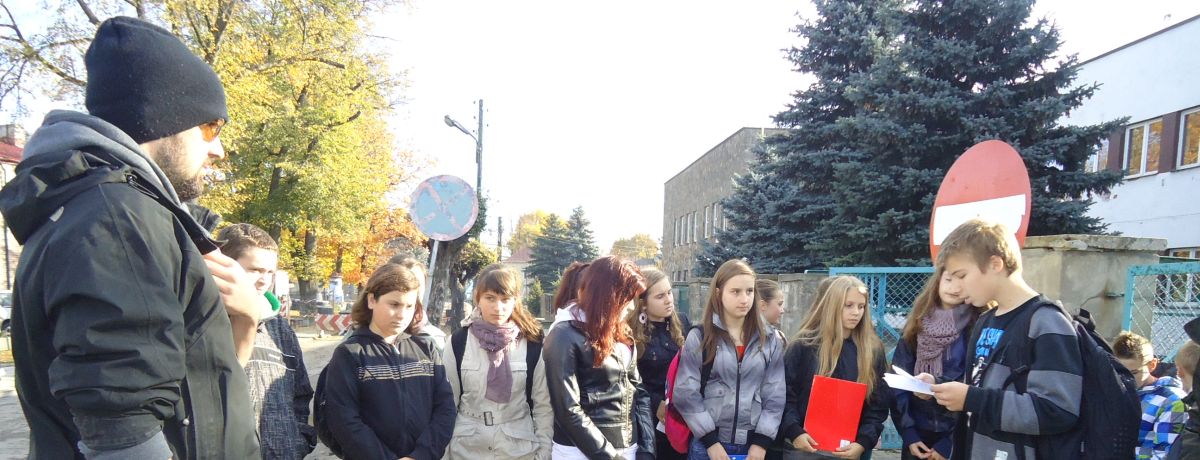Wąchock
Major Jan Piwnik “Ponury” Public Junior High School


Even though nobody knows much about him, Abram Lewi Pinkwas, a photographer and a glazier born in 1904 in Wąchock, became the main tour guide around the pre-war town history. He was personated by one of the students from the Major Jan Piwnik „Ponury” Junior High School. It was the second time that this school participated in the School of Dialogue workshops. When Abram Lewi Pinkwas was 7, the Jewish community was established in
Wąchock. In the same year, a Jewish cemetery was built, with a mikvah and a synagogue to follow. Before that Jews living in Wachock were governed by a qahal in Szydłowiec, and then in Iłża and Wierzbnik. In 1929, Jews in Wąchock were again included into the Community in Wierzbnik. Jews were mainly traders and craftsmen. Pinkwas was a son of Mordka Lewi who, just like his son further on, was a glazier. Others traded in textiles, leather, food products. Or, they had their own workshops, i.e. tailor, leather, carpenter or shoe making workshops. On the eve of the World War II, they constituted 20% of the population of Wąchock. On October 22 1942, they were transported to the death camp in Treblinka.
Before they were taken, a few photographs and documents from the Lewi family were given to a woman living in Wąchock with a request to transfer them further on to Jews when they would return to Wąchock… During the School of Dialogue workshops, students were looking at the Abram Lewi Pinkwas family photos.
The workshops helped students to become familiar with their town’s Jewish history. Their attention was drawn to Pinkwas, who could be seen in the old photographs, along with his wife and three children or a group of other men. These specific individuals who decades ago lived in their town, presented a completely different world to the junior high students, with this world being Poland before the World War II. When preparing for the tour concluding their participation in the School of Dialogue program, students used various sources, like archives, libraries, museums, they also talked with the eldest residents of Wąchock. The talks with Anna Perchel, who remembered the times from before the war, introduced them to the life in the pre-war shtetl.
On November 16, the participants of the School of Dialogue organised a walking tour following the footsteps of Jews of Wąchock. The event was attended by younger first-year students, teachers and the school principal. One of the students, Krzysztof, presented the history of Jews from Wąchock by playing the role of Abram Lewi Pinkwas. During the tour, the figure of Jan Ciok was also recalled. He was a resident of Wąchock who in 1993 was awarded the medal of the Righteous Among the Nations. The participants went to the place where the kosher meat stalls used to be located, and there students explained the rules of kosher food.
Next, they all went to the building of the former synagogue. The view was depressing: the building was ruined, its roof collapsed, there were no windows, bricks were falling apart and rubbish were scattered all around it. It was not easy to imagine its former magnificence of the times where the Lewy family prayed there, just before the Nazis damaged the synagogue.
Students then preceded to the house where one of the richest Jews in Wąchock once lived. Another stop along the route included the cemetery. The tour participants took a closer look at the stone matzevot, while the junior high students presented them the history and significance of this place to Jews. They listened to the explanations concerning symbols placed on the headstones with great interest. What the symbol of hands relates to, the symbol of tzedakah, a lion or a tree. Then, all of them went to the church where during the war the parish priest hid Jews with the help of town residents. The last stop along the route included the school building attended by Jewish children, also Pinkwas’ daughter, as proves the photograph from June 1938.
This is where the tour ended, but not the participation of the junior high school from Wąchock in the School of Dialogue program. During a year to follow, other students would again follow the footsteps of Jews from Wąchock.
The meetings taught me about Jewish culture and Jewish families in Wąchock … These meetings lead me to discover the history of Wąchock, a town which was once inhabited by Jews. I know that the knowledge of Jewish history and culture will be useful for me. The workshops were a great experience.
Żaneta, workshops participant

School:
Major Jan Piwnik “Ponury” Public Junior High School
Honorable mention:
2nd Award at 2013 School od Dialogue Gala
Students:
2nd year students
Teacher:
Katarzyna Szlęzak
Educators:
Małgorzata Kruszewska, Stanisław Niemojewski
School of Dialogue program in Wąchock was made possible by the support from SHIRLEY and HENRY HACKEL.
In appreciation to the Conference on Jewish Material Claims Against Germany (Claims Conference) for supporting this educational program. Through recovering the assets of the victims of the Holocaust, the Claims Conference enables organizations around the world to provide education about the Shoah and to preserve the memory of those who perished.

In appreciation to Friends of the Forum for supporting the School of Dialogue educational program.
